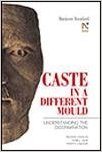In the post-Mandal debates, one commonsensical understanding has emerged that the dalits (Scheduled Castes/Tribes) are more disadvantaged and deprived than the Other backward Castes/Classes (OBCs) and therefore their demands for reservations can be justified but not of the affluent OBCs. The Supreme Court also bowed to this observation and invented a ‘creamy layer’ category in order to provide the profits of social justice agenda especially to the ‘real’ needy one. The idea of economic backwardness has thus plunged into a new debate which eventually shadowed the basic idea of ‘proportionate representation’ of the socially and educationally backward com-munities. The critics tried to locate the reser-vation policy as poverty reduction programme and condemned its strict association with caste categories. It has been argued that caste is just one category to understand social marginali-zation and economic and other structural opportunities (education, medical facilities and living conditions) are the necessary elements for the betterment and empowerment of the socially deprived communities.
Lack of data is the cry word for the policy makers and social scientists especially when it comes to making policies for the marginalized social groups. However, data hides more than it reveals. The consistent fascination for empi-rical data and case studies to substantiate any popular claim has created enough space for symptomatic remedies without delving into the core issues. This is a normally stated fact that there are widened disparities between various caste groups and the dalits (Scheduled Castes/Tribes) are the worst-off sections amongst the population. The latest Business Standard’s pub-lication Caste in a Different Mould has no new story to narrate when it comes to the data. It overwhelmingly suggests that the dalits in most of the comparisons related to the patterns of consumption lack basic amenities (health care and primary education) and in the graph of economic progress this group has the smallest middle class.

